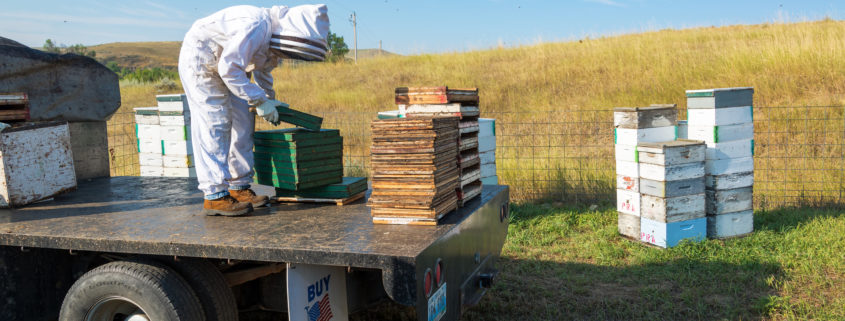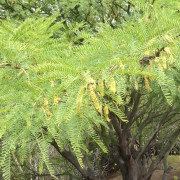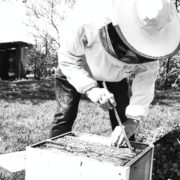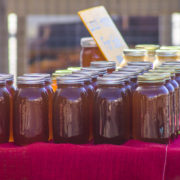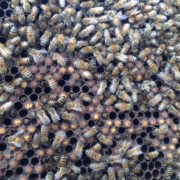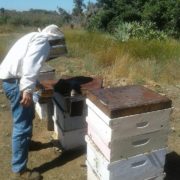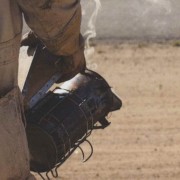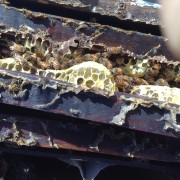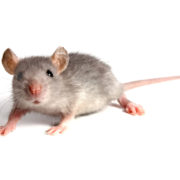Harvesting Honey Supers
When it comes time to harvest honey – that magical moment that you have been waiting for! – there are several methods available to get the job done. While no one method is necessarily better than another, some methods are better suited to hobbyists, whereas others are more appropriate for commercial or larger-scale beekeepers.
The basic goal of honey harvesting is to separate the bees from the honey and to remove a honey super off the beehive without taking any bees with it. The bees store honey in the super – it’s where they cure and maintain the honey. In any strong honeybee colony, there will be bees inside working on tasks such as maintaining the temperature of the colony and building beeswax to coat and preserve the frames of honey. Your goal when harvesting is to clear them out so you are not carrying bees back to your house or facility.
The first and most commonly used method of removing the honey super is with what is known as a fume board. It is used by both hobbyists and commercial beekeepers alike, including us here at Wildflower Meadows. (The beekeeper in the photo is gathering his fume boards.) A fume board is typically coated with a chemical repellant that drives the bees downward, away from the frames of honey. It’s placed on top of the honey super, clearing the box of bees below.
If you are a backyard beekeeper and only have one or two honey supers to harvest, another simpler method is to use a basic bee brush. A bee brush is an inexpensive and invaluable tool used by all beekeepers, which works great if you only have a small amount of honey to harvest. When using a bee brush, simply pull the honey frames out one by one and gently brush the bees away. This method is more time-consuming than other methods, but it is perfectly effective for a small-scale hobbyist.
There is one thing you should be cautious of when using a bee brush, however. If you have not placed a queen excluder below your honey super, there is always the risk that the queen may have wandered up into the honey super. You do not want to brush a queen honeybee and risk potential injury to her abdomen or damage to her sensitive reproductive system. If you are not using a queen excluder and are brushing bees off your honey frames, you will want to look for the queen on the frames you are pulling first. If you find the queen, it would be best to carefully place her back into the hive by gently picking her up by her wings or thorax.
Another popular honey harvesting method used by hobbyists is using a device called a hive escape board. This is a one-way entrance that allows bees to fly out of the honey super but not back inside. This is an easy and stress-free way of clearing bees out of a honey super, however, it is time-consuming, usually requiring at least 24 hours to be effective.
We have experimented with various escape boards over the years, but generally have been disappointed. The main disadvantage of an escape board is that the honey super itself must be in pristine condition, with no holes or cracks where the bees can reenter. Sometimes the bees will escape through the escape board and simply reenter through a nearby hole! Or worse, the bees escape through the board, only to have robber bees enter through a hole, starting a robbing episode. Another concern with escape boards can be that ants and small hive beetles can quickly gain the upper hand as bees disappear from the super. In a healthy colony, guard bees are guarding the honey for a reason. If they are drained out of the honey super with an escape board, there will be few or no guard bees remaining to protect against infiltrators, leaving pests free to run amok.
Many commercial beekeepers who have thousands of boxes of honey to harvest, have no time for brushing frames, using escape boards, or often even for fume boards. Instead, some of these no-nonsense beekeepers choose to go for the most efficient and speediest method of honey harvesting – the bee blower.
A bee blower is basically a glorified leaf blower that literally blows the bees right out of the box! While some mechanical blowers are specifically marketed for beekeeping, a beekeeper could literally use an actual leaf blower to blow bees during honey harvesting. Beekeepers who use blowers typically tip a honey super on its side before they powerfully blow the bees right out of the super, either in the direction from top to bottom, or bottom to top.
Although this is fast, efficient, and effective, it also is loud and obnoxious. Bee blowers quickly destroy the natural ambiance of an apiary and have the unfortunate side effect of making bees, (and peaceful beekeepers alike) angry and annoyed. Realistically, bee blowers are another method where beekeepers should use queen excluders. Without a queen excluder, the queens could be blown all across an apiary and lost for no reason!

